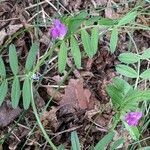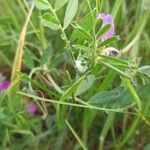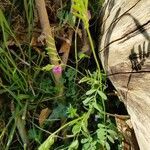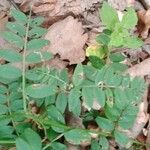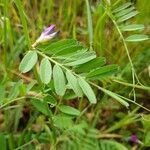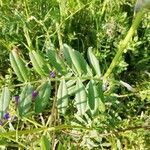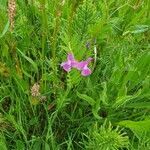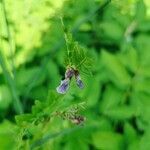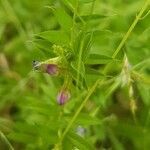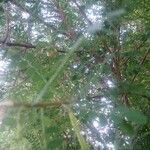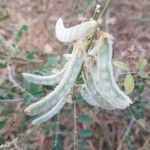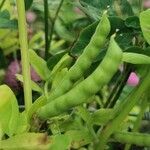Herbs annual, 15-100 cm tall. Stem unbranched to much branched, decumbent or climbing, puberulent or pilose. Leaves paripinnate, 2-10 cm; stipules hastate, semisagittate, or lanceolate, ca. 1.5 mm, 2-5-toothed, puberulent; leaflets 2-7-paired, linear to oblong-cuneate to obcordate, 9-25 × 2-10 mm, hairy, apex acute, obtuse, truncate, or emarginate, mucronate; lateral veins not obvious; tendril 2-or 3-branched. Flowers 1 or 2(-4) in axillary fascicles. Calyx campanulate, hairy; teeth shorter than to longer than tube. Corolla blue-purple or purple to red, (8-)10-30 mm; standard long obovate or obovate, constricted at middle, subequaling or longer than wings; wings longer than keel. Ovary shortly stalked, linear or fusiform, puberulent or hairy; ovules 5-8. Legume black, brownish black, brown, or yellow-brown, linear or linear-oblong, slightly curved, contracted or not contracted between seeds, 25-70 × (2.5-)3-11 mm, pubescent to glabrous, apex beaked. Seeds 4-8, spheroid. Fl. Jan-Aug, fr. Feb-Sep. 2n = 10, 12, 14.
Slender to stout scrambling or tufted annual; stem sparsely hairy. Lvs sparsely to densely hairy; tendrils branched; leaflets in (3)-4-8 pairs, often alternate, linear to elliptic to obovate, (5)-10-30-(40) mm long; stipules simple or with 1, adaxial, basal lobe, or dentate, usually with a dark spot. Infl. much < lvs, 1-2-(4)-flowered. Peduncle much < fls, rarely ± = fls. Pedicel 1-5 mm long. Calyx somewhat gibbous at base; calyx teeth ± equal, tube. Corolla usually purple, reddish purple or rose, sometimes white or pink, (8)-12-28 mm long; limb of standard > claw. Pod ± glabrous or puberulent, blackish or brownish black, constricted or not between seeds, 5-12-seeded, (20)-30-60 mm long; seeds light or dark brown with dark spots; hilum ⅙-⅕ of circumference.
Annual, herbaceous vine, 0.2-1.5 m high; glabrescent. Leaves with rachis terminating in ramified, prehensile tendril. Leaflets 4-18, ± oblong-lanceolate, 10-40 x 2-15 mm, apex emarginate, mucronulate. Stipules bearing purplish nectary. Inflorescences axillary, 1 or 2(3) flowers. Flowers violet purple. Calyx ± half as long as standard petal; teeth linear-subulate, lower three bearing yellow-brown nectary; not gibbous at base. Petals: standard 18-30 mm long. Flowering time Aug.-Jan. Pod without stipe, 35-80 x 6-12 mm, yellowish to brown, oblique, acute at both ends. Seeds 5-13, ± subspherical, greenish ochre.
Slender annual to 1 m, erect to ascending, often climbing; lfls 4–8 pairs, oblong to elliptic or even obovate, or sometimes linear, 1–3.5 cm; stipules half-sagittate, often sharply serrate, with a glandular spot beneath; fls mostly paired in the upper axils, subsessile, violet or purple, rarely white, 18–30 mm; cal-tube campanulate, 5–7 mm, its lobes linear-subulate, the upper 3–7 mm, the lower 4–9 mm; fr flattened, light brown, 2.5–7 cm, 4–12-seeded; 2n=12. Native of s. Europe, widely cult. in numerous races, and often escaped in our range. July–Sept.
Leaves 6–16-foliolate, lower ones 2–4-foliolate; leaflets 9–35 × 1–11(15) mm, linear to broadly oblong, oblong-obovate or obcordate, acute, obtuse, rounded or emarginate at the apex and usually mucronate or shortly cuspidate, usually cuneate at the base, sparsely pilose on both surfaces or glabrescent; petiole up to 8 mm long; rhachis usually terminating in a branched tendril; petiolules c. 0.5 mm long; stipules up to 8 mm long, semi-sagittate, entire or dentate, with a dark glandular median spot.
A straggling annual herb. It is 10-70 cm long. The stems can be hairy. The leaflets are 2-12 and vary in shape. They are 0.3-4 cm long by 0.2-1.5 cm wide. They often have a projecting sharp tip. They are wedge-shaped at the base. There is a branched tendril at the end of the upper leaves. The flower is pea like and the standard is pale blue. Flowers are 2-2.5 cm long. The fruits are pods 4-5.7 cm long and 6-8 mm wide. There are 8-10 seeds. The seeds are 4-5 mm across.
Corolla 10–30 mm long, light reddish-purple, bluish or mauve; standard 6–11 mm wide, obovate, emarginate; wings 2–3 mm shorter than the standard, the lamina equalling or exceeding the claw and oblong-obovate with a long auricle; keel ± two-thirds as long as the wings, the lamina broadly oblong, shorter than the claw.
Calyx sparsely pubescent to subglabrous; tube 3.5–7 mm long, slightly asymmetrical at the base, the mouth not oblique; lobes subequal, equalling or shorter than the tube, linear-lanceolate.
Like V. benghalensis but a sparsely hairy, trailing annual, with linear to obtriangular leaflets in 3-10 pairs, and with 1 or 2, ± sessile flowers in leaf-axils.
Style dorsally compressed, pubescent all round towards the apex and with a tuft of longer hairs below the apex on the lower edge.
Pod narrowly oblong, 25–50 × 4–9 mm, brownish-black, pubescent to glabrous.
Flowers 1–2 in the axils, subsessile or very shortly pedicellate.
Straggling or ascending annual herb up to 80 cm tall.
Stems angular, sparsely pubescent to subglabrous.
Seeds 2.5–6 mm in diameter, subglobose, smooth.
